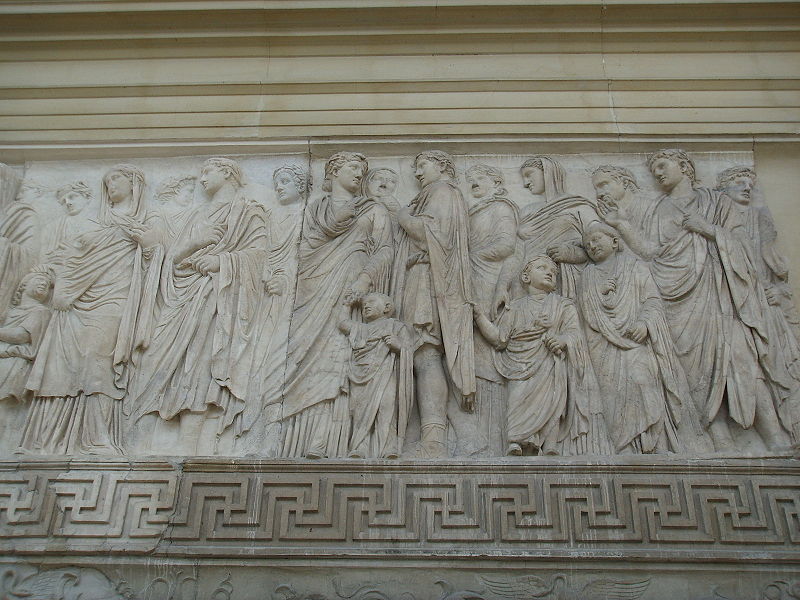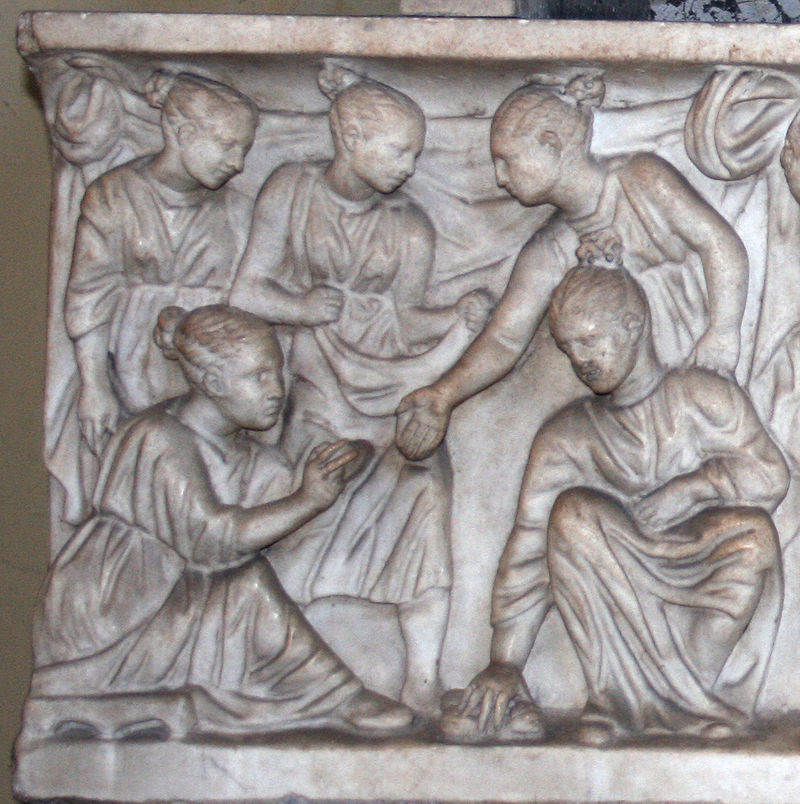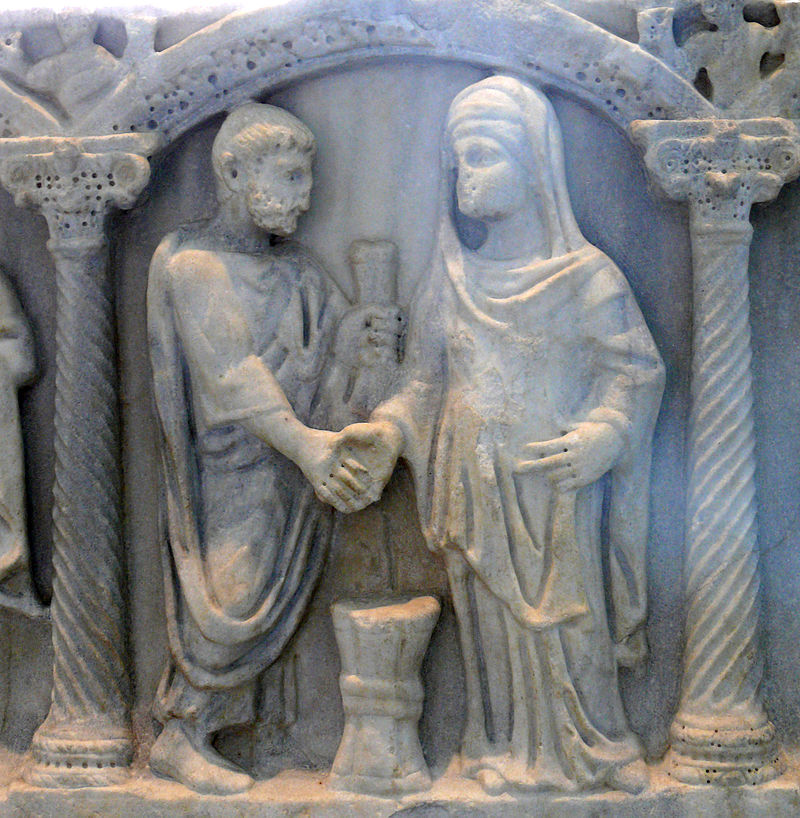The Roman Household Posted by andregurgel on Feb 12, 2019 in Intro to Latin Course, Latin Language, Roman culture
Note: This blog post is a companion to Unit II of our Introduction to Latin Vocabulary course. You can learn more about the course here.
What if I were to tell you that the Roman family wasn’t very different from most modern western societies? Hearing that may sound weird at first, I realize that. After all, how can a society which flourished thousands of years ago be similar to ours? Well, even though some politicians and civil servants insist that the Classics have no place in our lives, our society has always been influenced by the works of Greek and Roman classical thinkers, and that’s why there is still a lot of Roman culture in all of us. Roman society expected each married person to have only one spouse, and couples were encouraged to have children in order to perpetuate the family name. In fact, Augustus, the first Roman emperor, created laws which imposed heavier taxes on unmarried men and women!
In this article, we will have a look at the different members of the Roman household: the pater familias (lord of the household), the wife, the children and the elderly. I will show you how Roman weddings were celebrated as well. The takeaway is that learning about our ancestors’ way of life can help us understand our own.
The Paterfamilias
The word paterfamilias is a compound from pater (father) and the word familias (an old form of the genitive of familia (family)). The paterfamilias was the head of the Roman household and the whole family had to obey him. The power that subdued the other members of the household was known in Roman Law as patria potestas. In the early days of Rome, according to The Law of the Twelve Tables, a father could sell his child three times into slavery, meaning that if he did it a fourth time he would lose his patria potestas and the child would no longer be bound to him.
The Romans had a religious cult which was conducted at home and the paterfamilias was in charge of worshipping the household gods. Every Roman household had its own gods which were represented by the dii parentes (shades of ancestors) and the lares (household guardians). The paterfamilias was responsible for the cult of those deities and each family had its own religious calendar, which included ceremonies such as the coming of age, marriage and burials.
Roman women
The Romans were a great people and pioneers in many areas of knowledge. On the other hand, they were as backwards as most civilizations when it came to women’s rights. While women in Ancient Egypt were allowed to become doctors (see the tale of Peseshet), Roman women were always subject to the authority of their husbands or of other male family members. They did have some rights (like inheriting property), but they were not allowed to vote or hold public office (the only exception being the Vestal Virgins, priestesses of the goddess Vesta). In fact, women were not allowed to participate in public affairs until many centuries later, thanks to the suffragist movement.
Although the Romans saw women as inferior to men, there were women like Livia (wife of Augustus) who were active in politics. I strongly recommend reading the novel “I, Claudius” by Robert Graves and watching the series by the same name. In a remarkable passage, the author says that “if Augustus was the head, Livia was the neck”.
Marriage was the basis of a Roman woman’s life. Women’s main contribution to the State was producing healthy and gifted children. When a puella (young woman) was twelve years old, she was allowed to marry. While men were allowed to have mistresses, the Romans expected women to be chaste and virtuous. In fact, a law from the days of Augustus dictated that women convicted of adultery should be forced into prostitution.
Roman marriage
Marriage was a sacred rite among the Romans. The first reference to marriage in Roman history dates from the rule of the first king, Romulus. There weren’t enough women among the Romans, so they invited a neighboring people, the Sabines, to a festival, and then abducted their women. Romulus went to see the women and promised them that they could leave or choose to marry a Roman and be recognised as Roman citizens. If you wish to read a summarized version of this story, I recommend the “Abridgment of Roman History” by the third Century historian Eutropius.
The Romans had three types of marriage, resembling our modern wedding institutions. The main sources for them are found in the “Institutae” by Gaius. Rich patricians (noblemen), and later on plebeians, would often have confarreatio in which they had a big party and the bride and groom shared a piece of cake, known in Latin as panis farreus, pretty much like we do with the wedding cake. Then the father would take his daughter’s hand and place it in her husband’s. That symbolised the passing of patria postestas from the father to the husband in the presence of ten witnesses and the pontifex maximus (high priest).
Another kind of marriage was called coemptio (“by purchase”), which was very common among plebeians. Less solemn than confarreatio, it only demanded five witnesses and the groom was required to pay the father of the bride. Is this perhaps the origin of mail-order brides?
Last but not least, there was a type of marriage known as usus. The word literally means ‘by use’. If a couple lived together for a year, Roman Law considered them legally married. This is perhaps the origin of today´s concept of cohabitation as a valid form of marriage.
Roman children
We are not sure about the number of children that a Roman household would normally have, but it’s very likely that families were small due to high mortality rates. As mentioned before, children were subject to patria potestas and the paterfamilias even had the power to kill his own offspring (although that is rarely mentioned by historians). Boys came of age when they were 14 and women when they were 12. Boys and girls were educated very differently: while girls were trained in housekeeping, boys were taught how to become virtuous Roman citizens. The transition between childhood and adulthood happened for boys in a ceremony in which they first wore the toga virilis (a long toga worn by Roman citizens). Apparently, for women, there were no coming-of-age ceremonies, apart from matrimony itself.
Last but not least, the Romans had a strong sense of filial piety, which was expressed by the Latin word pietas (piety). A good example of filial piety may be seen in the fall of Troy when Aeneas carries his father Anchises out of the burning city. His father was a cripple and wouldn’t be able to flee the city if it weren’t for his son. If you want to know how Anchises was made a cripple by the goddess Aphrodite, I recommend reading the Homeric Hymns.
The Romans always looked towards their ancestors for examples of virtue. At the shrines of Roman homes, they used to place death masks known as imagines maiorum which resembled their late ancestors. One of the most bizarre Roman traditions is that those masks were used during funerals by professional actors who would impersonate the deceased in every way. Everyone else would feel as if the person who had died were watching his own funeral!
I hope to have shown that learning about past civilizations can help contextualize and understand our own society. As we have seen, the Roman family wasn’t all that different from today’s families, with the glaring exceptions of the institution of slavery and the legal subordination of women to their “masters”. In any case, our cultural debt to the Roman Empire is far greater than most of us realize.
GLOSSARY OF LATIN WORDS AND TERMS
pater familias– lord of the household.
conferratio-traditional patrician form of marriage which involved the bride and bridegroom sharing a cake of spelt.
imagines maiorum– masks that represented the ancestors.
panis farreus– bread shared by the bride and groom at the conferratio ceremony.
patria potestas– power of the pater familias over his wife and children
pontifex maximus– high priest of Roman religion.
coemptio– marriage by purchase
toga virilis– clothing worn by Romans after they came of age.
usus– cohabitation. A sort of marriage in Ancient Rome.
puella– girl
lares– household deities
dii parentes– shades of ancestors.
pietas– filial piety
References
Brevarium ab urbe condita. Eutropius.
The Homeric Hymns. Loeb Classical Library.
Institutae. Gaius

Build vocabulary, practice pronunciation, and more with Transparent Language Online. Available anytime, anywhere, on any device.







Comments:
A G Maxwell:
In some societies the groom pays the dowry to the woman’s father, it is a way of buying ‘coemptio’. When a man gifts the woman a diamond ring and any other presents, it takes the nature of coemptio, and when the couple contribute equally, it is a common sharing in the marriage expenses, a buying or shopping together i.e coemptio.
Hedvig:
Thank You for the great content!
I use your blog to take my mind off of the day’s challenges. Referencing further readings also piqued my interest to seek out the stories when I can make time for it.
Thanks again! I’m always ready for some more 🙂